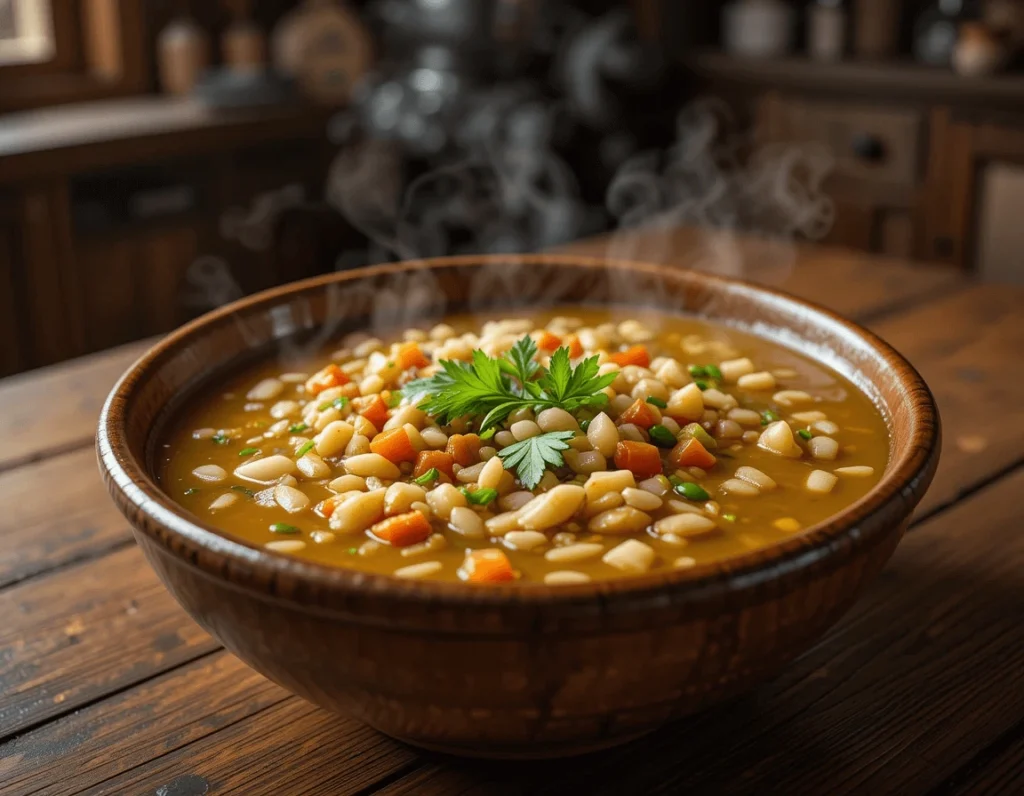Porcupine Soup is a hearty, nutritious, and flavorful dish that has been cherished for generations. This soup is known for its rich taste, comforting warmth, and unique texture, which comes from the combination of ground meat and rice forming small “quill-like” shapes. Whether you’re looking for a wholesome meal to nourish your body or a flavorful dish to satisfy your taste buds, this recipe has something to offer.
Beyond its delicious taste, Porcupine Soup is packed with health benefits. It contains essential nutrients, vitamins, and minerals that support overall well-being. Plus, its simple preparation makes it an excellent choice for home cooks of all skill levels.
In this article, we’ll explore the health benefits of Porcupine Soup Recipe, guide you through a step-by-step recipe, and share expert tips to elevate your cooking experience. By the end, you’ll have everything you need to create a nourishing and flavorful dish that your family will love.

Key Benefits of Porcupine Soup
Porcupine Soup is more than just a comforting meal—it’s a nutritional powerhouse packed with essential vitamins, minerals, and protein. Whether you’re looking to boost your immune system, improve digestion, or enjoy a hearty dish that keeps you full for longer, this soup delivers numerous health benefits.
1. High in Protein for Muscle Growth and Repair
Protein is a crucial nutrient that supports muscle growth, tissue repair, and overall body function. Porcupine Soup typically includes ground meat, such as beef, turkey, or chicken, which provides a rich source of high-quality protein. Consuming protein-rich foods like this soup helps:
- Strengthen muscles by providing essential amino acids.
- Support metabolism, aiding in weight management.
- Keep you full longer, reducing unnecessary snacking.
For those looking to boost their daily protein intake in a delicious and satisfying way, Porcupine Soup is an excellent choice.
2. Packed with Essential Vitamins and Minerals
This soup contains a variety of ingredients that contribute to overall health. Here’s a breakdown of some key nutrients found in Porcupine Soup:
- Vitamin A (from carrots) – Supports eye health, immunity, and skin regeneration.
- Vitamin C (from tomatoes and bell peppers) – Helps strengthen the immune system and improve iron absorption.
- Iron (from meat and leafy greens) – Essential for oxygen transport in the blood, reducing fatigue.
- Zinc (from meat and garlic) – Boosts immune function and supports wound healing.
A single bowl of Porcupine Soup can nourish your body with essential nutrients, making it a great addition to a balanced diet.
3. Supports Digestive Health with Fiber-Rich Ingredients
A healthy digestive system plays a key role in nutrient absorption and overall well-being. Porcupine Soup includes fiber-rich ingredients like rice, quinoa, and vegetables, which:
- Aid digestion by promoting healthy gut bacteria.
- Regulate blood sugar levels, preventing energy crashes.
- Support weight management by keeping you full longer.
For those looking to improve digestion naturally, this soup provides a balanced combination of fiber and easy-to-digest proteins.
4. Strengthens the Immune System
Porcupine Soup is loaded with immune-boosting ingredients such as garlic, onions, and tomatoes. These contain antioxidants and anti-inflammatory properties that:
- Fight harmful bacteria and viruses to keep you healthy.
- Reduce inflammation, supporting heart health.
- Improve overall immunity, making your body more resilient to infections.
Including Porcupine Soup in your diet, especially during colder months, can help protect your body from seasonal illnesses.
5. A Wholesome and Comforting Meal
Beyond its nutritional benefits, Porcupine Soup is the ultimate comfort food. Its warm, hearty texture makes it:
- Perfect for cold weather or when you’re feeling under the weather.
- Great for families, as it’s easy to prepare and loved by both kids and adults.
- A nutritious meal prep option, as it stores well and tastes even better the next day.
With its balanced blend of proteins, carbohydrates, and vegetables, Porcupine Soup is a complete meal that satisfies hunger and supports overall health.
“For more information on the nutritional value of rice and its benefits, check out the USDA FoodData Central database.”
Ingredients for Porcupine Soup
Creating a rich and flavorful Porcupine Soup starts with selecting the right ingredients. This hearty dish combines protein, grains, and vegetables, offering a nutritious and satisfying meal. Below is a breakdown of essential ingredients, their benefits, and optional additions to enhance the dish.
Essential Ingredients
1. Ground Meat (Beef, Turkey, or Chicken) – 1 lb (450g)
- The main source of protein in the soup.
- Helps with muscle growth, energy production, and tissue repair.
- Choose lean meat for a lower-fat version or ground turkey/chicken for a lighter alternative.
2. Uncooked Rice (Long-Grain or Brown) – ¾ cup (150g)
- Gives the soup its unique texture, resembling porcupine quills.
- Provides complex carbohydrates for long-lasting energy.
- Brown rice adds more fiber and nutrients for digestive health.
3. Diced Tomatoes – 1 can (14.5 oz / 400g)
- Adds richness and acidity, balancing the flavors.
- A great source of vitamin C and antioxidants to boost immunity.
4. Onion (Chopped) – 1 Medium
- Enhances flavor and aroma.
- Contains quercetin, a compound known for its anti-inflammatory properties.
5. Garlic (Minced) – 3 Cloves
- Boosts immune function and adds a depth of flavor.
- Contains allicin, known for its antibacterial and heart-healthy benefits.
6. Carrots (Diced) – 2 Medium
- Adds natural sweetness and beta-carotene, which supports eye health.
- Provides fiber for digestive support.
7. Celery (Chopped) – 2 Stalks
- Contributes a subtle crunch and natural saltiness.
- Rich in antioxidants and gut-friendly fiber.
8. Chicken or Beef Broth – 4 Cups (1 Liter)
- Forms the flavor base of the soup.
- Choose low-sodium broth for better control over salt levels.
9. Tomato Paste – 2 Tablespoons
- Intensifies the umami flavor and adds thickness.
- Enhances the rich, deep red color of the soup.
10. Worcestershire Sauce – 1 Tablespoon (Optional)
- Adds a hint of tangy, savory depth.
- Helps bring out the natural flavors of the meat.
11. Dried Thyme – 1 Teaspoon
- Provides a subtle earthy and herbal aroma.
- Known for its antimicrobial properties.
12. Salt and Black Pepper – To Taste
- Enhances the overall flavor profile.
- Adjust based on preference.

Optional Ingredients for Customization
For Extra Nutrition:
- Add spinach or kale for a boost of iron and vitamins.
- Mix in bell peppers for additional vitamin C and natural sweetness.
Spicy Kick:
- Sprinkle red pepper flakes or diced jalapeños.
- A dash of cayenne pepper adds warmth without overpowering the dish.
Low-Carb Alternative:
- Replace rice with cauliflower rice to cut down on carbohydrates while maintaining texture.
For a Vegetarian Version:
- Swap out meat for lentils, chickpeas, or mushrooms for a protein-rich alternative.
- Use vegetable broth instead of chicken or beef broth.
Ingredient Selection Tips
- Choose fresh, organic vegetables whenever possible for the best flavor and nutrition.
- Use homemade broth for a richer, preservative-free base.
- Opt for high-quality ground meat with minimal additives.
By gathering these wholesome ingredients, you’re preparing a soup that’s not only delicious but also packed with essential nutrients.
Step-by-Step Instructions for Making Porcupine Soup Recipe
Now that you have all the ingredients ready, follow these steps to prepare a rich, hearty, and flavorful Porcupine Soup. This method ensures maximum flavor while keeping the process simple and efficient.
1: Prepare the Ingredients
Before cooking, ensure all ingredients are prepped for an efficient cooking process.
- Chop the onions, carrots, and celery into small, uniform pieces.
- Mince the garlic to release its full flavor.
- Rinse the rice under cold water to remove excess starch. This prevents the soup from becoming too thick.
2: Sauté the Vegetables
- In a large, heavy-bottomed pot or Dutch oven, heat one tablespoon of olive oil over medium heat.
- Add the chopped onions and sauté for two to three minutes until they become soft and translucent.
- Stir in the carrots and celery, cooking for another three to four minutes until they start to soften.
- Add the minced garlic and cook for about 30 seconds, stirring frequently to avoid burning.
3: Brown the Meat
- Add the ground beef, turkey, or chicken to the pot.
- Cook for five to seven minutes, breaking it apart with a spoon until it browns evenly.
- Stir occasionally to ensure even cooking and prevent sticking.
- If there is excess grease, carefully drain some of it, but keep a small amount for added flavor.
4: Add the Rice and Tomatoes
- Stir in the rinsed rice, mixing well with the meat and vegetables.
- Add the tomato paste and stir to evenly coat all ingredients.
- Cook for two minutes, allowing the tomato paste to deepen in flavor.
5: Pour in the Broth and Simmer
- Pour in the broth, stirring to combine all ingredients.
- Add salt, black pepper, thyme, and any additional seasonings.
- Bring the soup to a gentle boil, then reduce the heat to low.
- Cover and let the soup simmer for 20 to 25 minutes, or until the rice is tender.
- Stir occasionally to prevent rice from sticking to the bottom of the pot.
6: Adjust Seasoning and Serve
- Taste the soup and adjust the seasoning if needed. Add more salt or pepper to enhance the flavors.
- If the soup is too thick, add a little extra broth to reach the desired consistency.
- Remove from heat and let it sit for a few minutes before serving.
- Ladle into bowls and garnish with fresh parsley for added freshness.
Porcupine Soup Recipe is now ready to be enjoyed. This dish is perfect for a hearty meal and can be stored for later use. The flavors deepen over time, making leftovers even more delicious.

Pro Tips and Variations
Making Porcupine Soup is simple, but a few expert tips can elevate its flavor and texture. Whether you want to enhance the taste, adapt it to dietary needs, or experiment with new ingredients, these tips and variations will help you perfect your dish.
Pro Tips for the Best Porcupine Soup Recipe
✔ Sauté for Depth of Flavor – Browning the meat and sautéing the vegetables before adding broth enhances the richness of the soup. The caramelization adds a deep umami taste.
✔ Use Homemade Broth – If possible, opt for homemade broth instead of store-bought. It provides a fresher taste and allows you to control the sodium levels.
✔ Simmer Slowly – Let the soup simmer over low heat for at least 25 minutes to allow the flavors to meld together. Stir occasionally to ensure even cooking.
✔ Adjust the Consistency – If the soup thickens too much, add extra broth or water to reach your preferred texture. If it’s too thin, let it simmer uncovered for a few more minutes.
✔ Season Gradually – Always season in layers. Add a little salt and pepper at the start, then adjust toward the end for a perfectly balanced taste.
✔ Let it Rest Before Serving – Allow the soup to sit for five minutes off the heat. This helps the flavors develop further, making it even more delicious.
Recipe Variations
1. Vegetarian Porcupine Soup Recipe
- Replace ground meat with lentils or mushrooms for a plant-based version.
- Use vegetable broth instead of chicken or beef broth.
- Add extra vegetables like bell peppers, zucchini, or spinach for more nutrients.
2. Spicy Porcupine Soup
- Add ½ teaspoon of red pepper flakes or diced jalapeños for extra heat.
3. Low-Carb Porcupine Soup
- Swap rice for cauliflower rice to reduce carbs.
- Use lean ground turkey or chicken instead of beef for a lighter option.
- Increase the amount of low-carb vegetables like celery, spinach, and bell peppers.
4. Creamy Porcupine Soup
- Stir in ½ cup of heavy cream or coconut milk for a rich and creamy texture.
- Add a small amount of cheese, such as Parmesan, for a deeper flavor.
5. Mediterranean-Style Porcupine Soup
- Use ground lamb instead of beef for a Mediterranean twist.
- Add cumin, coriander, and a pinch of cinnamon to enhance the flavor profile.
- Stir in chopped fresh parsley and a squeeze of lemon juice before serving.
Make-Ahead and Storage Tips
✔ Make-Ahead – Prepare the soup in advance and refrigerate it for up to three days. The flavors will deepen over time, making it even tastier.
✔ Freezing – Let the soup cool completely before storing it in airtight containers. Freeze for up to three months.
✔ Reheating – Warm it over low heat on the stovetop or microwave in short intervals, stirring occasionally to maintain the texture.
By using these tips and variations, you can customize Porcupine Soup Recipe to suit your taste and dietary needs while ensuring every bowl is flavorful and satisfying
Serving Suggestions
A bowl of Porcupine Soup Recipe is satisfying on its own, but pairing it with the right sides and garnishes elevates the experience. Here are some serving ideas to enhance flavor, texture, and presentation.
Best Side Dishes
- Crusty Bread – A warm baguette, sourdough, or dinner rolls are perfect for dipping into the savory broth.
- Fresh Garden Salad – A light salad with crisp greens, cherry tomatoes, and a lemon vinaigrette balances the heartiness of the soup.
- Roasted Vegetables – Serve with roasted carrots, Brussels sprouts, or zucchini for an extra serving of nutrients.
- Grilled Cheese or Flatbread – A simple grilled cheese sandwich or herbed flatbread makes a comforting companion.
- Steamed Rice or Quinoa – If you want to make the dish even heartier, serve it over a bed of rice or quinoa.
Garnishing for Extra Flavor
Adding the right toppings can enhance both the taste and visual appeal of Porcupine Soup:
- Fresh Herbs – Sprinkle with chopped parsley, cilantro, or thyme for a burst of freshness.
- Cheese – A light dusting of grated Parmesan or crumbled feta adds a savory depth.
- Lemon or Lime Wedge – A squeeze of citrus brightens the flavors and balances the richness.
- Crushed Red Pepper – For those who enjoy a little heat, a pinch of red pepper flakes works wonders.
- Toasted Nuts or Seeds – Slivered almonds or pumpkin seeds add crunch and extra nutrition.
Presentation Tips
- Use Deep Bowls – Serve in deep, wide bowls to keep the broth warm longer and make it easier to scoop.
- Drizzle with Olive Oil – A small drizzle of high-quality olive oil enhances the soup’s richness.
- Layer Ingredients – Add fresh herbs or cheese just before serving to maintain their texture and flavor.
- Serve with a Soup Spoon – A wide, deep spoon ensures you get the perfect bite of meat, rice, and broth.
By pairing Porcupine Soup with the right sides, garnishes, and thoughtful presentation, you can transform a simple meal into a restaurant-quality experience at home.
Conclusion
Porcupine Soup is more than just a meal—it’s a nourishing, comforting dish that brings warmth and nutrition to every bowl. With its hearty blend of protein-rich meat, fiber-packed rice, and vitamin-loaded vegetables, this soup offers a satisfying balance of flavors and health benefits. Whether you’re looking for a cozy dinner on a chilly evening or a meal that the whole family will love, this recipe delivers on all fronts.
Beyond its great taste, Porcupine Soup is incredibly versatile. You can customize it to fit different dietary needs, experiment with spices, or enhance it with unique ingredients to match your preferences. Plus, it’s easy to prepare and perfect for batch cooking—making it an excellent choice for meal prep and busy weeknights.
By following the serving suggestions and pro tips, you can elevate this dish into something truly special. Whether enjoyed on its own or paired with a side of crusty bread and a fresh salad, this soup is a comforting, wholesome option that never disappoints.
So why not give Porcupine Soup Recipe a try? Gather your ingredients, follow the simple steps, and experience the delicious, nourishing magic of this timeless dish.

FAQs
Here are answers to some common questions about Porcupine Soup to help you make the best version of this delicious dish.
1. Can I freeze Porcupine Soup?
Yes! Porcupine Soup freezes well. Let it cool completely before transferring it to an airtight container. It can be stored in the freezer for up to three months. When ready to eat, simply thaw it in the refrigerator overnight and reheat on the stovetop or in the microwave.
2. Can I make Porcupine Soup Recipe vegetarian?
Absolutely! You can substitute the ground meat with lentils, mushrooms, or plant-based crumbles for a vegetarian version. Using vegetable broth instead of meat-based broth will also keep the dish fully plant-based while maintaining its hearty texture and rich flavors.
3. How can I make the soup spicier?
If you like heat, add red pepper flakes, diced jalapeños, or a pinch of cayenne pepper during cooking. Adjust the amount to your spice preference for a bolder kick.
4. What type of rice works best for Porcupine Soup?
Long-grain white rice is the traditional choice, but brown rice, jasmine rice, or quinoa can be used for a healthier alternative. Just note that different grains may slightly change the cooking time.
5. Can I prepare Porcupine Soup in advance?
Yes! This soup actually tastes even better the next day as the flavors deepen. Store it in the refrigerator for up to 4 days in an airtight container. Reheat on the stove over medium heat, stirring occasionally, until warmed through.
6. What can I serve with Porcupine Soup?
Pair it with crusty bread, cornbread, or a fresh green salad for a complete meal. You can also top it with fresh herbs, grated Parmesan, or a squeeze of lemon to enhance the flavors.
If you have more questions, feel free to experiment and make Porcupine Soup your own! Happy cooking!
“If you love comforting soups, check out our guide to hearty homemade soups for more delicious recipes!”


3 thoughts on “Porcupine Soup Benefits & Recipe: Everything You Need to Know”